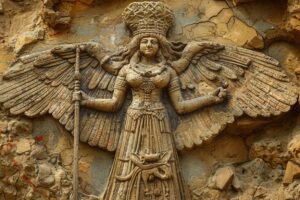Fertility Goddess Telepinu: Origins, Myths, and Symbolism

Fertility goddess Telepinu is a key figure in Hittite mythology. Known as the son of the storm god Taru and the sun goddess Arinniti, he is associated with agriculture and prosperity.
Telepinu’s disappearance caused great chaos, leading to infertility and famine. His myth includes significant symbols like the bee, which played a crucial role in restoring balance and fertility.
Origins and Characteristics of Telepinu
Telepinu holds a crucial role in Hittite mythology with deep connections to agriculture and prosperity.
His characteristics and origins shed light on his significant influence.
Telepinu’s Lineage
Telepinu is the son of the storm god, Taru, also known as Tarḫunna, and the sun goddess, Arinniti. His divine heritage establishes his importance within the pantheon of Hittite deities.
His marriage to the goddess Ḫatepuna, and sometimes association with Šepuru and Kataḫḫa, further emphasizes his esteemed position.
Attributes of Telepinu
Telepinu is primarily recognized as a god of agriculture and fertility. However, his attributes extend beyond this domain, also encompassing elements of storm power and harvest cycles. His volatile nature, marked by human-like emotions such as anger and confusion, reflects the interconnectedness of his presence with the natural world’s well-being.
Festivals and Worship Practices
Telepinu was honored during grand festivals held every nine years in locations such as Ḫanḫana and Kašḫa. These celebrations included:
- The sacrifice of a thousand sheep and fifty oxen.
- The replanting of an oak tree as a symbol of Telepinu.
These rituals underscore the deep cultural emphasis on ensuring agricultural prosperity and appeasing the deity to maintain cosmic balance.
The Myth of Telepinu
The myth of Telepinu captures a narrative where the god’s disappearance leads to chaos and infertility in the land, emphasizing the importance of divine presence for harmony and prosperity.
The Disappearance of Telepinu
Telepinu’s sudden departure from the world initiates a catastrophic series of events.
His absence is felt universally, leading to a cessation of fertility and a period of widespread desolation.
Consequences of His Absence
The world plunges into chaos as Telepinu withdraws. Plants and animals cease to reproduce, leading to famine and despair:
- Mist and smoke envelop windows and houses, symbolizing confusion and loss of clarity.
- Sheep and cows refuse their young, indicating a profound disruption in natural cycles.
- The cessation of agricultural activity reflects the abandonment of the life-giving forces previously maintained by Telepinu.
Symbolism of His Rage
Telepinu’s rage is a central theme, representing a powerful force capable of disrupting the natural order:
- His misplaced shoes symbolize a cosmic disarray, indicating the breakdown of social and natural order.
- His anger and departure metaphorically represent the impact of unchecked divine displeasure on the physical world.
Role of the Bee in the Myth
A significant turning point in the myth is the intervention of a bee, which plays a crucial role in restoring balance and order.
Significance of the Bee
The bee’s role is emblematic, reflecting themes of fertility and renewal:
- Bees are traditionally associated with fertility due to their role in pollination.
- The bee’s search for Telepinu and subsequent actions are both significant for their practical and symbolic implications.
Purification Rituals
Purification is a key aspect in the restoration of Telepinu’s vitality and the world’s fertility:
- The bee stings Telepinu to awaken him, symbolically cleansing his eyes and feet with wax.
- This act of cleansing represents the return of clarity and order, previously lost due to Telepinu’s rage and departure.
- The rituals performed to calm and purify Telepinu are examples of ancient practices aimed at restoring harmony between the divine and the earthly realms.
Symbolism in Telepinu’s Mythology
The mythology surrounding Telepinu is rich with symbolism, providing deep insights into ancient Hittite beliefs and their understanding of cosmic order and chaos.
Anthropomorphic Traits
Telepinu is depicted with highly human characteristics such as anger, frustration, and fatigue. These traits make him relatable and emphasize his importance in maintaining balance in the natural world.
His human-like behavior underscores the gods’ close connection to human experiences, especially in agricultural societies where deities were often portrayed with emotions and actions mirroring those of the people who honored them.
Metaphors of Chaos and Order
Shoes and Disarray
One striking symbol of chaos in Telepinu’s myth is the image of him putting on his shoes incorrectly. This act represents the disruption of the natural order and introduces disorder into the world.
The incorrect use of shoes signifies a state of confusion and imbalance, suggesting that even minor disruptions can have significant impacts on the cosmic equilibrium.
Mist and Smoke Imagery
The recurring imagery of mist and smoke enveloping the house and windows symbolizes loss of clarity and vision. This serves as a metaphor for the widespread confusion and disarray caused by Telepinu’s absence.
Mist and smoke obscure vision and understanding, tying physical disorientation to the broader cosmic chaos. This imagery highlights the interconnection between the divine actions of Telepinu and the natural world’s state.
Restoration of Fertility
The return of Telepinu marks the restoration of fertility and order. His awakening and purification, facilitated by the bee’s intervention, symbolize the re-establishment of prosperity in both the natural and divine realms.
Fertility is a crucial theme, reflecting the agricultural society’s dependency on divine favor for successful harvests. The purification rituals performed upon Telepinu’s return cleanse the chaos, reinstating the balance necessary for growth and sustenance.
Key Characters in Telepinu’s Myth
Several key characters play essential roles in the myth of Telepinu, each contributing uniquely to the narrative and symbolism surrounding this Hittite deity.
Taru, the Storm God
Taru, also known as Tarḫunna, is the storm god in Hittite mythology. He holds significant influence over both the natural and divine realms. As the father of Telepinu, he is deeply concerned about his son’s wellbeing and the consequences of his actions on the world.
Taru’s role is multifaceted, being a god responsible for storms. This position highlights the Hittite connection between natural phenomena and divine actions. His storms could be both a source of nourishment and destruction, showing his powerful duality.
His relationship with Telepinu emphasizes the familial connections among deities and their collective impact on fertility and prosperity. This dynamic illustrates the interconnectedness of the gods in maintaining cosmic order.
Hannahanna, the Mother Goddess
Hannahanna is a central maternal figure in Hittite mythology.
Known as the mother goddess, she embodies nurturing and stability. Her wisdom and counsel are vital in resolving the crisis caused by Telepinu’s disappearance.
When other gods are confused, Hannahanna steps in with a pragmatic solution.
She suggests sending a bee to search for Telepinu, showcasing her resourcefulness and deep understanding of nature’s role in mythology. Her actions reflect her position as a problem-solver and protector of balance.
Hannahanna’s intervention underscores the importance of compassion and maternal instincts in restoring harmony. Her character teaches valuable lessons about the power of nurturing and strategic thinking in overcoming divine and natural disruptions.
Kamrušepa, the Magic Goddess
Kamrušepa is the Hittite goddess of magic and healing. Her specialty lies in rituals and magical practices that purify and alleviate chaos. In the myth of Telepinu, her role becomes crucial when the simple act of finding Telepinu is not enough to quell his rage.
Kamrušepa uses her magical abilities to transfer Telepinu’s anger to the Guard of the Underworld. This ritualistic transfer is symbolic of removing destructive energy and restoring equilibrium. Her actions are not only powerful but also demonstrate the deep-rooted belief in the effectiveness of ritual and magic.
The character of Kamrušepa exemplifies the Hittite reverence for magic as a vital force in maintaining cosmic order. Her presence in the myth reinforces the theme that divine anger and chaos can be managed and reversed through specialized knowledge and practices.
Comparative Mythology
Comparing the myth of Telepinu with other mythologies reveals many common themes and influences present in ancient narratives.
Old Anatolian Myths
The myth of Telepinu fits within a category known as the “Old Anatolian Myths.” These myths often revolve around the themes of disappearance and return, reflecting agricultural cycles and the deep connection between deities and natural phenomena.
In these narratives, the temporary absence of a god or goddess disrupts the natural order, causing widespread distress until their return restores balance and fertility.
Examples of this theme can be found in other Anatolian myths such as the story of the goddess Inara, who also faces ordeals that impact the natural world.
These myths underscore the centrality of agricultural and seasonal cycles in ancient Anatolian society.
Parallels with Greek Myths
Many elements of Telepinu’s story echo myths from ancient Greece. For instance, the Greek myth of Persephone shares striking similarities. In this myth, Persephone’s descent into the underworld causes a period of infertility and despair until her eventual return marks the renewal of life and earth’s fertility.
Greek mythology also includes figures akin to Telepinu such as Demeter, who is associated with harvest and fertility. The thematic resemblance between Telepinu’s anger and its catastrophic effects and Demeter’s sorrow over Persephone highlights the common mythological motif of a deity’s emotional state directly affecting the natural world.
Cultural Connections and Influences
- Many ancient cultures shared similar concerns about agricultural fertility, often personifying these ideas through gods and goddesses.
- Such cross-cultural mythological themes suggest a shared human experience with nature and the cycles of growth and decline.
- The spread of these myths across different regions hints at cultural exchanges and influences, where stories adapted to local contexts but retained core elements.
Telepinu’s myth parallels those found in Mesopotamian and other Near Eastern traditions, highlighting broader regional connections.
The similarities in myths across different cultures reflect the universality of certain fears and hopes, particularly concerning survival and prosperity.
Significance of the Bee
In the myth of Telepinu, the bee plays a crucial role in restoring balance. This is significant as bees are often seen as symbols of fertility and industriousness. In many traditions, bees represent renewal and the preservation of life through their role in pollination and their production of honey.
The bee’s symbolic role in the Hittite myth further connects to other cultures, demonstrating how small, seemingly insignificant creatures hold substantial meaning within larger cosmic narratives.
Cultural Significance of Telepinu
Telepinu played a vital role in Hittite culture, especially in their agricultural and religious practices.
Agricultural Dependence
The Hittites deeply relied on Telepinu for agricultural success. They believed that his presence ensured fertile lands, abundant harvests, and the overall prosperity of their society. When Telepinu disappeared, it symbolized drought, famine, and societal disorder.
This belief underpinned their agricultural routines and seasonal cycles, making Telepinu’s favor essential for survival.
Rituals and Priest Roles
Rituals dedicated to Telepinu were integral to maintaining cosmic balance and agricultural fertility. These ceremonies often included offerings, prayers, and symbolic acts aimed at appeasing the deity and ensuring his return from periodic absences.
Festivals Dedicated to Telepinu
- Large-scale sacrificial rituals every nine years, prominently featuring sacrifices of livestock like sheep and cattle.
- The replanting of sacred oak trees, which symbolized the continued presence and blessing of Telepinu.
Roles of Priests
Priests acted as intermediaries between Telepinu and the people.
They performed intricate ceremonies to pacify the god and restore fertility. These rituals included the use of aromatic oils, special offerings, and the recitation of mythological stories to evoke Telepinu’s favorable aspects.
Telepinu in Modern Understanding
In contemporary times, Telepinu’s myth provides valuable insights into ancient Hittite beliefs and practices. Researchers study these myths to understand the cultural and religious fabric of the Hittites, comparing them to other ancient civilizations.
Legacy and Influence
Telepinu’s narrative continues to be a subject of academic interest, exploring its similarities with other fertility myths globally. His story reflects the universal themes of chaos, order, and the essential relationship between humans and nature.
Frequently Asked Questions
This section addresses common questions about Telepinu in Hittite mythology, focusing on his role, the impact of his anger, the symbolism of bees, and comparisons to other myths.
What is Telepinu’s Role in Hittite Religion?
Telepinu was a significant deity in the Hittite pantheon, primarily associated with fertility and agriculture. As the son of the storm god Taru and the sun goddess Arinniti, Telepinu played a vital role in ensuring the prosperity of crops and livestock.
His wellbeing was directly linked to the health of the land.
Festivals dedicated to Telepinu were celebrated with grand rituals and sacrifices, reflecting his importance. These festivals involved replanting a sacred oak tree, symbolizing the continuous rebirth and sustenance provided by the god.
The rituals underscored the community’s dependence on Telepinu for agricultural success.
How Did Telepinu’s Anger Affect the World?
Telepinu’s anger had catastrophic consequences for the natural world and human society. When he became enraged and disappeared, his absence led to a series of natural calamities.
Consequences of His Absence
- Vegetation withered, causing crops to fail.
- Livestock became barren, refusing to give birth.
- Humans and gods alike suffered from widespread famine.
The widespread desolation underscored Telepinu’s critical role in maintaining the natural order.
His emotional turmoil was mirrored in the environment, emphasizing the interconnectedness between the divine and the earthly realms.
Symbolism of His Rage
Telepinu’s anger symbolized chaos and disorder, disrupting the cosmic balance. His action of putting on his shoes incorrectly demonstrated the confusion and disarray caused by his wrath. Mist and smoke obscuring the house and altar represented loss of clarity and vision, further illustrating the turmoil his emotions could unleash.
What Do Bees Symbolize in His Myth?
Bees hold a significant role in the myth of Telepinu. They were sent by the mother goddess Hannahanna to find and awaken Telepinu, ultimately restoring balance and fertility.
Significance of the Bee
Bees are often associated with fertility due to their crucial role in pollination. In the context of Telepinu’s myth, the bee symbolizes an effective agent of search and restoration. Its involvement highlights its vital function in agricultural cycles and the renewal of life.
Purification Rituals
The bee not only locates Telepinu but also purifies him by stinging him awake and smearing his eyes and feet with wax. This act of cleansing restores clarity of vision and reinvigorates Telepinu, allowing the natural order to be reestablished.
These actions are mirrored in Hittite purification rituals involving oils and offerings to appease deities and restore harmony.
How Do Other Myths Compare to Telepinu’s Story?
Telepinu’s narrative fits within a broader genre of ‘disappearing god’ myths found in various cultures. These myths often involve a deity whose absence results in catastrophic consequences for the world.
Old Anatolian Myths
Comparable myths from Old Anatolian cultures often feature gods whose temporary departure causes ecological and societal distress. These stories reflect the ancient worlds’ struggles to understand natural cycles and their dependence on divine favors.
Parallels with Greek Myths
- The myth of Persephone, whose absence brings about winter until her return signifies spring’s arrival.
- Similarities in themes of fertility, seasonal cycles, and the impact of divine emotions on the natural world.
Cultural Connections and Influences
The tale of Telepinu shows cultural exchanges between different ancient societies.
His story shares elements with myths from regions as varied as Greece and the Caucasus, suggesting a shared understanding of the divine’s role in ensuring fertility and balance.





















